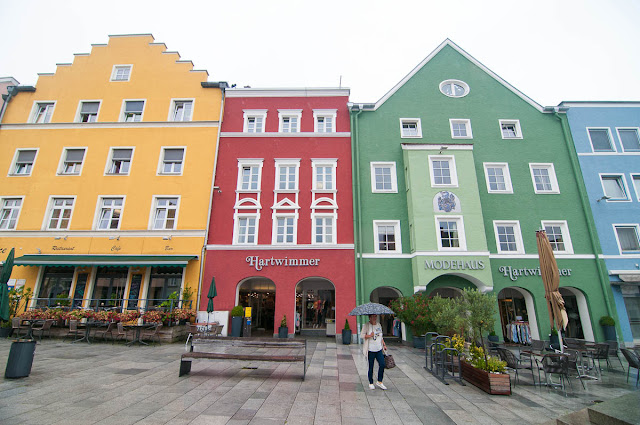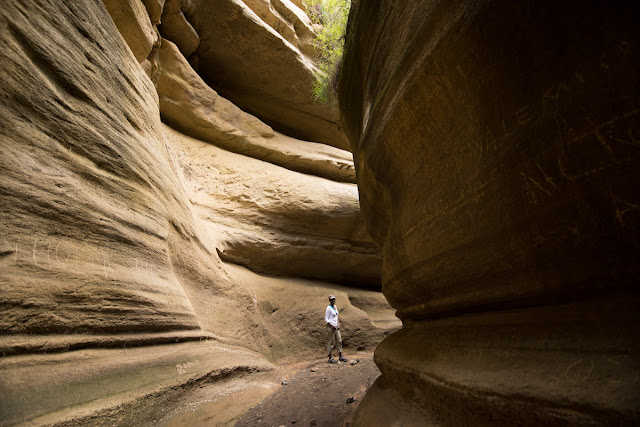Italy: The Vatican Museum is Ridiculously Huge. So is St. Peter's Basilica.
The Vatican Museum is a world class museum, but also has a world class price of entry. Also, you have to line up for a couple of hours to get in. But, completely randomly, we discovered that it was going to be 'International Tourism Day' (whatever that is) and entry would be free for the day and boy did this appeal to our budget traveller mentality! Relieved of the need to make change and swipe cards, the line was super short and in 10min we were through the security AND fashion police (no bare shoulders or miniskirts) and into one of the largest museums in the world.
This beautiful staircase is actually at the end of the tour, but I had to get your attention somehow! Hang on to the end for the interesting story about it's design...but first! We must learn about the tiniest country in the world: Vatican City. It is only 110 acres, and has a population of 1,000. It is also guarded by the smallest army in the world, the Swiss Pontifical guard, whose main outstanding attribute is their colorful uniform. Oh, and they really are Swiss.
In the middle of the the museum is this huge courtyard, with the intriguing sculpture in the center. By the time tested method of eavesdropping on passing tour groups, we found out that it either represents the fragility of the world we live in, or the complexity of the world we live in. Later on, I found that the artist, Arnaldo Pomodoro, has never explained what his spheres mean, but he has made various versions of them all over the world. Either way its a cool sculpture - the spheres can be spun by hand and rotate within each other.
As with all the great museums in the world, you cannot see everything in one go. So here are a few highlights. Because of its location in Rome, It obviously contains a great deal of Roman history. Like the statue below: Emperor Tiberius. He was the emperor during Jesus' lifetime, until he died in 37 CE. He is mentioned by name in Luke 3:1, and would be the one to whom Jesus' listeners were to pay back Caesar's things.
Domitian ruled much later, but also has a connection to Bible history. He ruled from 81-96 CE and was a fierce opponent of Christianity. He was the first emperor to demand worship as a god. It is likely that during this period, John was exiled to Patmos.
We had planned to go the meeting that night, so we were all dressed up. Here's the whole gang:
The museum runs through the former personal residences of the popes, and these have been decorated sumptuously by many famous artists, primarily Raphael. The paintings are of various scenes, but my favorite are the 'supporting cast' of life size figures painted at the base of the frescoes that are made to look like pillars holding up the paintings above. The three dimensional effect is sooo lifelike.
Raphael was one of three artists considered the masters of the Renaissance - the other two being Michelangelo and Leonardo da Vinci. He died young at 37, but had put out a tremendous amount of work. One reason for this was his unusually large 'workshop' or team of under artists who would assist in doing less important parts of the painting. Apparently he was very good at negotiating and keeping everyone happy, unlike his more prickly compatriot, Michelangelo.
Speaking of Michelangelo, he created this little bit of artwork. It took him 4 years. It seems that Michelangelo didn't really like painting. He felt his main thing was sculpture. The pope basically ordered him to do it, but Michelangelo refused to paint specific pictures, demanding full choice on what would be painted. In his own words, he preferred to 'do as [he] liked.'
Unlike Raphael, he painted the entire thing by himself. He painted 343 figures, and apparently read and reread the Hebrew Scriptures to draw his inspiration. Generally speaking the figures are bible characters, though he did include a few pictures of 'Sibyls' or pagan prophetesses. Oh, and when he came back some years later to paint the 'Last Judgement' that you see on the right hand side wall, he didn't spend quite as much time in research.
On the tour route, you pop out of the Sistine Chapel and you are pretty much at the end of the tour. But there is one more highlight: the Bramante staircase. It's called that, but really that is more of the type of staircase it is. Bramante designed a staircase as a double helix. This means that if you look closely, the staircase actually has 2 pathways, so you could have up traffic on one staircase and down moving traffic on the other one. Here it is from the bottom looking up.
This beautiful staircase is actually at the end of the tour, but I had to get your attention somehow! Hang on to the end for the interesting story about it's design...but first! We must learn about the tiniest country in the world: Vatican City. It is only 110 acres, and has a population of 1,000. It is also guarded by the smallest army in the world, the Swiss Pontifical guard, whose main outstanding attribute is their colorful uniform. Oh, and they really are Swiss.
In the middle of the the museum is this huge courtyard, with the intriguing sculpture in the center. By the time tested method of eavesdropping on passing tour groups, we found out that it either represents the fragility of the world we live in, or the complexity of the world we live in. Later on, I found that the artist, Arnaldo Pomodoro, has never explained what his spheres mean, but he has made various versions of them all over the world. Either way its a cool sculpture - the spheres can be spun by hand and rotate within each other.
As with all the great museums in the world, you cannot see everything in one go. So here are a few highlights. Because of its location in Rome, It obviously contains a great deal of Roman history. Like the statue below: Emperor Tiberius. He was the emperor during Jesus' lifetime, until he died in 37 CE. He is mentioned by name in Luke 3:1, and would be the one to whom Jesus' listeners were to pay back Caesar's things.
The museum runs through the former personal residences of the popes, and these have been decorated sumptuously by many famous artists, primarily Raphael. The paintings are of various scenes, but my favorite are the 'supporting cast' of life size figures painted at the base of the frescoes that are made to look like pillars holding up the paintings above. The three dimensional effect is sooo lifelike.
Raphael was one of three artists considered the masters of the Renaissance - the other two being Michelangelo and Leonardo da Vinci. He died young at 37, but had put out a tremendous amount of work. One reason for this was his unusually large 'workshop' or team of under artists who would assist in doing less important parts of the painting. Apparently he was very good at negotiating and keeping everyone happy, unlike his more prickly compatriot, Michelangelo.
Unlike Raphael, he painted the entire thing by himself. He painted 343 figures, and apparently read and reread the Hebrew Scriptures to draw his inspiration. Generally speaking the figures are bible characters, though he did include a few pictures of 'Sibyls' or pagan prophetesses. Oh, and when he came back some years later to paint the 'Last Judgement' that you see on the right hand side wall, he didn't spend quite as much time in research.
Once you are done with the staircase, you pop out onto the street. Right round the corner is another huge edifice - St. Peter's Basilica. It's pretty difficult to get an idea of the size from just looking at a picture. But if you look closely at the picture you will see a mass of people lining up to enter from the right and another mass exiting to the left. They look like little ants in comparison. This building is ginormous.
There is a similarly ginormous line to get in that wraps around the massive courtyard. While we waited in line doing strange stretching exercises that Suzie always makes us do when we are in public and potentially embarrassing areas, I will give you a bit of history about the basilica. It seems that there has always been a church at the spot, but in 1506 Pope Julius commissioned the current one. It has had several architects including Michelangelo and Bernini. Just like his predecessors, Pope Paul III had a hard time convincing Michelangelo to take up the job (he was now in his 70s) and his terms were the same as previously. It was completed 120 years later.
Bernini designed the collonade that surrounds the courtyard. Though the columns are four deep, when you stand on one particular spot the perspective is so accurate that it appears to be just one column. It also gives you a nice vantage to see the tremendous line of people!
The general design ethos is: Why leave a surface unadorned if it can be inlaid with marble and overlaid with sculptures? The dome on the top is the world's largest and is 136 meters from the floor to the top. It's tough to see, but there are also people up in the ring directly below the windows in the dome which gives an idea of the size of the dome. Look out for the 2 security guards in the picture as well.
Our tour today had given us lots of beautiful artwork, impressive architecture, lots of food for thought, and a window into life in the Renaissance period. As ever with Rome, we went to bed tired, to rest for another day full of new things.

















